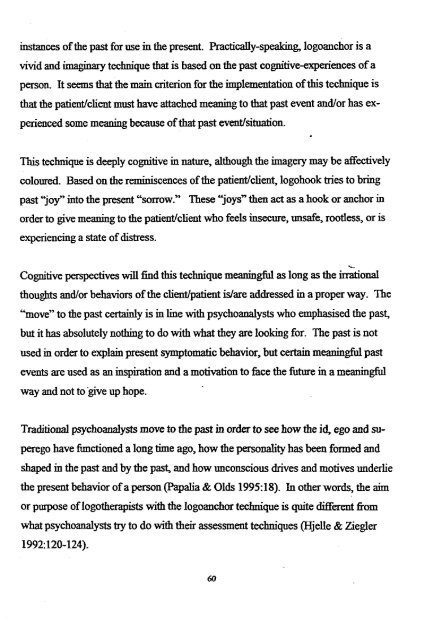View/Open - UZSpace Home
View/Open - UZSpace Home
View/Open - UZSpace Home
Create successful ePaper yourself
Turn your PDF publications into a flip-book with our unique Google optimized e-Paper software.
instances ofthe past for use in the present. Practically-speaking, logoanchor is a<br />
vividand imaginary technique that is based on the past cognitive-experiences ofa<br />
person. Itseems that the main criterion for the implementation ofthis techniqueis<br />
thatthe patient/client musthave attachedmeaning to thatpast event and/orhas ex<br />
perienced somemeaning becauseofthatpast event/situation.<br />
Thistechnique is deeplycognitive in nature, although the imagery may be affectively<br />
coloured. Based on the reminiscences ofthe patient/client, logohook tries to bring<br />
past "joy" intothe present "sorrow." These "joys" then act as a hook or anchorin<br />
orderto givemeaning to the patient/client who feels insecure, unsafe, rootless, or is<br />
experiencing a state ofdistress.<br />
Cognitive perspectives willfind this technique meaningful as long as the irrational<br />
thoughts and/orbehaviors ofthe client/patient islare addressed in a proper way. The<br />
"move" to the past certainly is in line withpsychoanalysts who emphasised the past,<br />
but it has absolutely nothing to dowith what they are lookingfor. The past is not<br />
used in orderto explain present symptomatic behavior,but certain meaningful past<br />
events are used as an inspiration and a motivation to face the future in a meaningful<br />
way and not to"give up hope.<br />
Traditional psychoanalysts move to the past in order to see how the id, ego and su<br />
peregohave functioned a long time ago, how the personality has been formed and<br />
shaped in the past andby the past, and how unconscious drives and motives underlie<br />
the presentbehaviorofa person (Papalia& Olds 1995:18). In other words, the aim<br />
or purpose of logotherapists withthe logoanchor techniqueis quite different from<br />
what psychoanalysts try to do withtheir assessmenttechniques (Hjelle & Ziegler<br />
1992:120-124).<br />
60
















